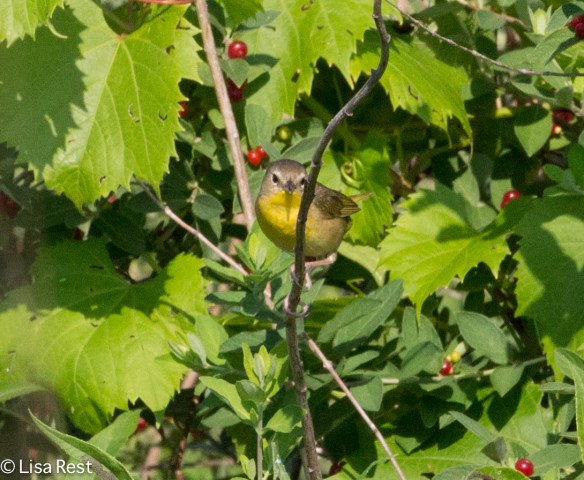
The 4th of July always reminds me to make my annual visit to Goose Lake National Prairie. I am not exactly sure why I don’t visit at other times of the year, and maybe I will decide to visit more often if I ever retire, but I like to go at this time because it’s not crowded, the prairie is beautiful and in bloom, and I can usually count on seeing Dickcissels and Henslow’s Sparrows.
As it turns out, this year it was particularly “not crowded” – I was the only human the entire length of my visit. I went on July 3rd instead of the 4th. It was already hot and sunny at 7:40 a.m. when I got out of my car and saw Killdeer in the parking lot.

As I started to walk the trail that goes out from the back of the Visitor’s Center, I was welcomed by a few Barn Swallows, one of which was having fun swooping close to my head. Perhaps it was trying to startle me, because it was pretty persistent, but I am quite used to birds flying around my head! My challenge was to try to capture the bird in flight. When I used to go down to the lakefront in the summertime on my lunch hour, there were swallows swooping around constantly close to people, but people were everywhere and pretty unavoidable. On this occasion, the handful of Barn Swallows outnumbered me.

Barn Swallow 
As for “target” birds, I saw only one Dickcissel and it was quite far away. I didn’t hear any more of them, either. I neither heard nor saw any Henslow’s Sparrows. I heard a lot of Marsh Wrens but could not see one.


Dickcissel 
But you can’t go birding on expectations and then be disappointed when they don’t pan out. There’s always a surprise or something interesting. I was delighted to see an Eastern Meadowlark.




Eastern Meadowlark
Common Yellowthroats seem particularly abundant this year. I think that is making them less skulky.








Common Yellowthroat
The prairie wasn’t in full bloom, but the Monarda and Prairie Spiderwort were attractive. At least I think it’s Prairie Spiderwort and not Ohio, although the leaves looked thicker than the variety I have in my backyard. Either one is native to Illinois.


Monarda

It is always nice to see Orchard Orioles. I found a female perched and one male in flight.


Song Sparrows were abundant.
A distant male Northern Harrier was harassed by a few Red-Winged Blackbirds.
I think this was the same Great Egret I saw perched at the pond by Cragg’s Cabin later.

Great Egret 


Cragg;s Cabin 
One tern flew by. It didn’t stay long enough to fish. There is a big man-made lake nearby, Heidecke Lake, which was formerly a cooling reservoir. That could be where the tern hangs out more often.

Two Great Blue Herons flew by. Likely one of them was the individual below who was fishing from the partially submerged boardwalk that is no longer functional for human use but served this bird’s purpose.



Red-winged Blackbirds typically outnumber everything else. But it seems like every place I go, I hear a new vocalization from them. Listen to this little trilly sound below.


Eastern Kingbirds were the prevalent flycatcher species.
There were a few Field Sparrows, not very close but still delightful to see and hear.
More birds…


Common Yellowthroat (female) 

Savannah Sparrow 

On my way out, a Kildeer flew by.
The last bird I saw was a House Sparrow by the Visitor’s Center.


This was only my first outing of last weekend. I came home to do some work later in the afternoon. But I got up and went to the Portage on Saturday morning and back to Goose Lake Natural Area on Sunday. I’ll try to get caught up before summer’s over!




































































































 An assortment of beautiful dragonflies made themselves available for photographs.
An assortment of beautiful dragonflies made themselves available for photographs.


 All I can say is I’ll have to go back to Orland soon. But this weekend I am off to Michigan to meet friends and find more birds and plants and insects… I will be back, I hope, with much to report.
All I can say is I’ll have to go back to Orland soon. But this weekend I am off to Michigan to meet friends and find more birds and plants and insects… I will be back, I hope, with much to report.







































































































